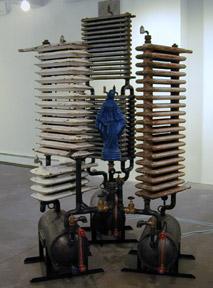Summer Installation - 3000°
dal 26/6/2003 al 7/9/2003
Segnalato da
26/6/2003
Summer Installation - 3000°
Paul Rodgers / 9W, New York
Michael Dominick, James Hegge, Win Knowlton, Mary Ziegler. The contemporary influence of the Smithson/Serra nexus, through Georges Bataille's solar lense. Welders use the round number of 3000 degrees to indicate the temperature at which iron melts, hence the title of the show. The exhibition will consist of four sculptures engaged with energy and its expenditure.

Michael Dominick, James Hegge, Win Knowlton, Mary Ziegler
The contemporary influence of the Smithson/Serra nexus, through Georges Bataille's solar lense.
Paul Rodgers/9W is pleased to present a summer group exhibition of contemporary sculpture by Michael Dominick, James Hegge, Win Knowlton and Mary Ziegler, all artists who have been associated with the sculpture program at 9W.
The great question facing contemporary art in America, after a car crash ended Jackson Pollock's life in 1956, appears to have been quite simply 'What do we do after Pollock'? Following the turbulent years of the 1960's, which saw the birth of Pop, Minimal, Performance and Conceptual art, the then editor of Artforum, Philip Lieder, has argued that, when Robert Smithson was killed in a plane crash in 1973, American art abandoned its effort to answer that question. This exhibition has a dual intention. Firstly, it pays tribute to the friendship between Robert Smithson and Richard Serra as being central to this challenge of understanding Pollock's legacy. Secondly, it argues that Georges Bataille, one of the great anti-academic thinkers of the twentieth century, played a clandestine role in the elaboration of an alternative art thought in America. The selection of recent sculpture by Dominick, Hegge, Knowlton and Ziegler is intended to demonstrate how this line of thought, linking Pollock to Smithson, Serra and beyond, persists in contemporary art.
Serra is on record as testifying to how Smithson's idea of entropy interested him and how Smithson in turn was interested in his thrown lead pieces. What is less well-known is that a copy of the first American translation of writings by Georges Bataille, under the title Death and Sensuality, published 1969, was in Robert Smithson's library and that he referred to Bataille in his own writings at a time when the philosopher was otherwise absent from art discourse in the United States. It is, therefore, historically established that contemporary American aesthetic thinking took note of Bataille at a key moment in its development and through the conduit of its most audacious conceptual mind. Both the style and content of Smithson's 1972 text The Spiral Jetty testifies to his involvement with Bataille's thought. It indicates that Smithson's central concept of entropy, the notion that matter inevitably reverts to inertia, should be seen in the larger context of Bataille's thesis of 'General Economy' driven by surplus solar energy. In this scenario, art must mediate issues of threat, disorientation, instability, dissolution, excess and, ultimately, questions of shifting identity. This exhibition proposes that these issues are at the heart of Pollock's legacy, that Smithson and Serra took them up and that each of the included artists continues to find new forms with which to explore them.
Welders use the round number of 3000 degrees to indicate the temperature at which iron melts, hence the title of the show. The exhibition will consist of four sculptures engaged with energy and its expenditure. Michael Dominick will present one of his found radiator pieces which will augment the temperature of the gallery to repellent levels above the normal heat of the summer season. It is intended that the visitor will experience discomfort in relationship to the exhibition space. Win Knowlton will present Speaker of the House from his recent one-man show at the gallery. This piece, through its perforated steel layers, captures the eye in a vortex, similar in effect to the solar vortex that Smithson speaks of at the Salt Lake, and provokes sensations of retinal vertigo. James Hegge will present a new piece, made during his recent residency at the Bemis Center of Contemporary Arts by throwing an object off an eight floor building and repairing the consequent damage, only to repeat the process over again and again. The work explores the effects of physical shock and stress on base matter, to produce a sculptural form which the artist would not otherwise have been able to invent through conscious decision making. Mary Ziegler will present a new kinetic sculpture using electro-magnetic force to evoke themes of manipulation and control, and their opposite, that are inherent in all natural, social and cultural systems.
Paul Rodgers / 9W
529 West 20th Street, 9th Floor
New York, NY 10011
t. 212.414.9810
f. 212.414.9844



